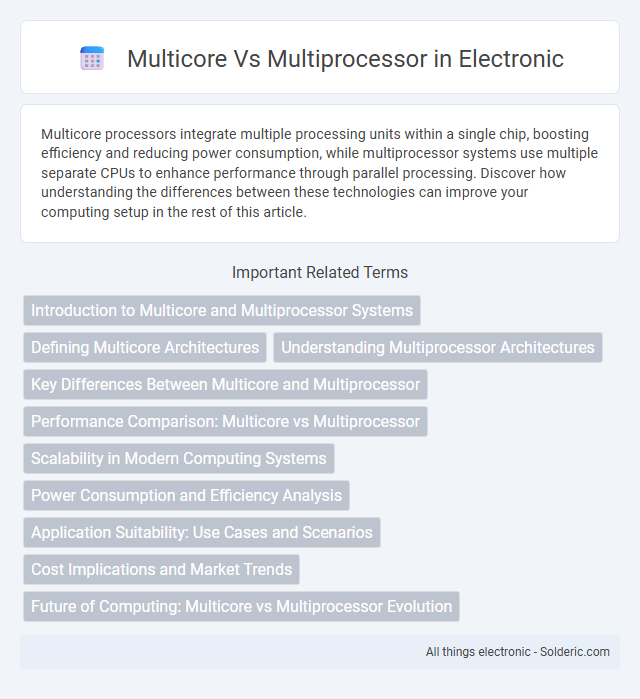Multicore processors integrate multiple processing units within a single chip, boosting efficiency and reducing power consumption, while multiprocessor systems use multiple separate CPUs to enhance performance through parallel processing. Discover how understanding the differences between these technologies can improve your computing setup in the rest of this article.
Comparison Table
| Aspect | Multicore | Multiprocessor |
|---|---|---|
| Definition | Single chip with multiple CPU cores | Multiple CPUs in a single system |
| Processor Units | Multiple cores on one die | Separate physical processors |
| Communication | Shared cache and memory | Inter-processor communication via bus or network |
| Performance | Efficient for parallel tasks on single chip | Higher raw processing power, better scalability |
| Power Consumption | Lower, due to integrated design | Higher, multiple chips increase power needs |
| Cost | Generally lower manufacturing cost | Higher, due to multiple CPUs |
| Use Cases | Mobile devices, desktops, laptops | Servers, supercomputers, large-scale computing |
Introduction to Multicore and Multiprocessor Systems
Multicore systems integrate multiple processing cores within a single chip, enhancing computational efficiency and power consumption compared to traditional single-core processors. Multiprocessor systems consist of multiple independent processors connected via a communication bus or network, offering increased parallel processing capabilities and fault tolerance. Both architectures aim to improve performance through parallelism but differ in chip design, communication methods, and application suitability.
Defining Multicore Architectures
Multicore architectures integrate two or more processing cores within a single physical chip, enabling parallel execution of multiple tasks to improve computational efficiency and performance. Each core in a multicore processor shares resources such as cache and memory controllers but operates independently, allowing your system to handle simultaneous processes more effectively. Understanding multicore designs helps optimize software and hardware collaboration, enhancing speed and power efficiency compared to multiprocessor systems with multiple separate chips.
Understanding Multiprocessor Architectures
Multiprocessor architectures consist of multiple independent CPUs within a single system, allowing parallel execution of processes to enhance computing power and fault tolerance. Multicore processors integrate several cores on a single chip, sharing resources and enabling efficient multitasking with lower power consumption and reduced latency compared to traditional multiprocessor setups. Understanding the distinction helps you optimize system performance by selecting the appropriate architecture for your workload requirements.
Key Differences Between Multicore and Multiprocessor
Multicore processors integrate multiple processing cores within a single chip, enabling higher efficiency and reduced power consumption, while multiprocessor systems consist of two or more separate CPUs connected to work together. You'll notice multicore processors share cache and memory resources more closely, promoting faster data exchange compared to multiprocessors that have independent caches and memory. The key differences lie in architecture, scalability, and communication latency, with multicore systems optimized for parallel tasks within a single chip and multiprocessors suited for larger, distributed computing environments.
Performance Comparison: Multicore vs Multiprocessor
Multicore processors integrate multiple cores within a single chip, offering enhanced performance through shared caches and lower latency communication, which improves efficiency for parallel tasks on your system. Multiprocessor systems combine multiple separate CPUs, delivering superior raw processing power and scalability, ideal for handling intensive workloads distributed across multiple physical processors. Your choice between multicore and multiprocessor architectures depends on the balance between cost, complexity, and the specific performance demands of your applications.
Scalability in Modern Computing Systems
Multicore processors enhance scalability by integrating multiple cores within a single chip, allowing efficient parallel processing and reducing latency in data sharing between cores. Multiprocessor systems scale by connecting multiple independent CPUs, offering higher computing power but often facing challenges with memory coherence and inter-processor communication overhead. Modern computing systems leverage multicore architectures for scalable performance in compact designs while using multiprocessor setups for large-scale, high-throughput applications requiring extensive resource pooling.
Power Consumption and Efficiency Analysis
Multicore processors integrate multiple cores within a single chip, significantly reducing power consumption compared to multiprocessor systems that use separate physical processors, which often generate higher heat and consume more energy due to duplicated hardware. Multicore architectures benefit from shared resources and lower inter-core communication latency, enhancing overall power efficiency and computing performance. Your choice between multicore and multiprocessor systems should consider workload demands, as multicore solutions often deliver better energy efficiency for parallel tasks within constrained power budgets.
Application Suitability: Use Cases and Scenarios
Multicore processors excel in applications requiring efficient parallelism within a single system, such as gaming, video editing, and real-time simulations, where shared memory access enhances performance. Multiprocessor systems are better suited for high-demand enterprise environments like database servers, scientific computing, and large-scale data processing, benefiting from multiple independent CPUs working concurrently. Understanding your application's workload characteristics helps determine whether a multicore or multiprocessor architecture will maximize performance and scalability.
Cost Implications and Market Trends
Multicore processors offer cost-effective solutions by integrating multiple processing cores on a single chip, reducing manufacturing expenses and power consumption compared to multiprocessor systems that require separate CPU units. The market trend shows a growing preference for multicore architectures in consumer electronics and mobile devices due to lower costs and improved energy efficiency, while multiprocessors continue to dominate in high-performance computing and enterprise servers where scalability and parallel processing are critical. Cost implications favor multicore designs for mass-market applications, whereas multiprocessor setups remain justified by performance demands despite higher infrastructure and maintenance costs.
Future of Computing: Multicore vs Multiprocessor Evolution
Multicore processors integrate multiple processing units within a single chip, offering efficient parallelism and reduced power consumption, while multiprocessor systems combine separate CPUs to enhance computational power for complex tasks. The future of computing leans towards hybrid architectures that blend multicore scalability with multiprocessor flexibility, enabling your systems to handle AI, big data, and real-time analytics more effectively. Advances in interconnect technologies and shared memory management will further drive the evolution of these architectures, optimizing performance and energy efficiency.
Multicore vs Multiprocessor Infographic

 solderic.com
solderic.com